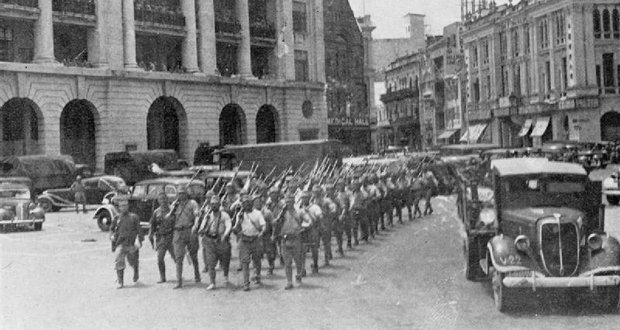On this day: Singapore fell

BY 1942 SINGAPORE was one of the jewels in the crown of the British Empire. Complete with the sobriquet ‘Gibraltar of the East’ for its presumed impregnability, it served as a major shipping and trading hub, an important commercial centre and naval base, and a bastion for burgeoning British interests in South-East Asia.
But after a disastrous campaign on the Malay Peninsula as the war in the Pacific got into full swing, overwhelmed British and Australian troops retreated there under the command of Lieutenant-General Arthur Percival and Australian Major-General Gordon Bennett, and with nowhere else to go, set up for a last stand.
The British sent the newly built HMS Prince of Wales and the battle-hardened HMS Repulse to aid the defenders, but they were sunk by Japanese torpedo bombers before they could get there.
Largest surrender in British war history
What followed was described by British Prime Minister Winston Churchill as “the worst disaster and largest capitulation in British history,” as the remaining 130,000 troops surrendered just a week after the first Japanese invasions, on 15 February 1942. Around 7,500 Allied troops were killed during the battle.
Percival had allocated the Western portion of the island to Bennett’s two brigades from the Australian 8th Division, but under increased pressure from the relentless Japanese advance, almost all Allied divisions had been forced from their positions, and by 15 February Percival was forced to surrender, and 15,000 Australians were thrown into captivity.
“The fall of Singapore was one of the largest defeats of the British Empire and a very dark day in Australia’s history,” says military historian Dr Lachlan Grant at the Australian War Memorial in Canberra.
The battle for Australia
“POW stories are central to Australia’s history in World War Two,” Lachlan says. “Prisoners of war accounted for half of our combat losses and 1-in-3 POWs died.” In total around 22,000 Australians were taken prisoner by the Japanese during the war and 8,000 of them died in captivity.
After the battle, Australian Prime Minister John Curtin predicted that “the battle for Australia” would soon follow.
As a result of Britain’s subsequently diminished military presence in Southeast Asia and their inability to effectively fight the Japanese (who by the 19th were bombing the Australian mainland), Curtin placed Australian forces under the command of US General Douglas MacArthur.
This marked a drastic shift in Australian foreign policy, turning away from Britain and focussing on strengthening ties with America, forming a diplomatic rapport that lasts to this day.

Australian soldiers at the Changi POW camp in Singapore. (Credit: Australian War Memorial)
RELATED STORIES

